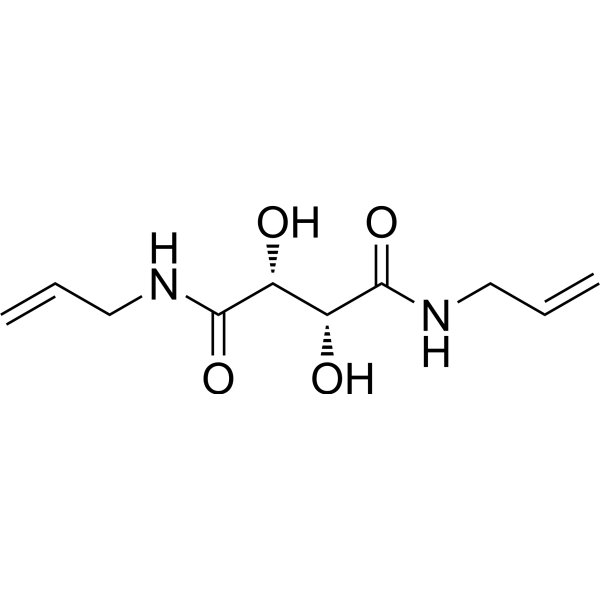
| 规格 | 价格 | ||
|---|---|---|---|
| 500mg | |||
| 1g | |||
| Other Sizes |
| 靶点 |
Biochemical Assay Reagent
|
|---|---|
| 参考文献 | |
| 其他信息 |
Enzymes, coenzymes and metabolites are the reagents characteristic of enzymatic analysis. Some of these materials must be prepared or isolated in the laboratory, but many are available commercially. Information about these materials is less readily available to the analyst than information about inorganic reagents. This situation is made worse by the multiplicity and variety of the definitions of purity. In 1955, the Committee on Biological Chemistry and Chemical Technology, National Academy of Sciences, National Research Council (USA) began to collect standard values for biochemical compounds1). As a result of this work the first volume of “Specifications and Criteria of Biochemical Compounds” was published in June 1960*). This volume does not contain chapters on “Phosphate Esters” and “Enzymes”.
This chapter examines the activity and the stability of biochemical reagents. The best criterion for the purity of an enzyme is the specific activity together with details of the activity of contaminating enzymes. The activity of these contaminants is expressed as a percentage of the specific activity of the enzyme described. The activities of the enzymes are given in units and the specific activity in units per mg protein. To conform to the proposed International Unit, a unit of enzyme activity is defined as the amount of enzyme which transforms 1 μmole of substrate in 1 min at 25°C. ADH contains up to 40 SH groups and 5 zinc atoms per molecule and therefore, it is sensitive to oxidizing and chelating agents. The crystalline suspension in 2.0 M (NH4)2SO4 solution containing 3% Na4P2O7 and 1% glycine is stable for several months at 0°C to 4°C when air is excluded, while at room temperature it is only stable for 1 week. Solutions or suspensions can be dialyzed against distilled water at 0°C to 3°C without any significant loss of activity. Triosephosphate isomerase is used as the auxiliary enzyme and glycerol-1-phosphate dehydrogenase as the indicator enzyme.[1]
|
| 分子式 |
C10H16N2O4
|
|---|---|
| 分子量 |
228.25
|
| CAS号 |
58477-85-3
|
| PubChem CID |
94074
|
| 外观&性状 |
Typically exists as solids at room temperature
|
| 密度 |
1.192 g/cm3
|
| 沸点 |
566.8ºC at 760 mmHg
|
| 熔点 |
186-188 °C(lit.)
|
| 闪点 |
296.6ºC
|
| 折射率 |
108 ° (C=2.4, H2O)
|
| LogP |
0
|
| tPSA |
98.66
|
| 氢键供体(HBD)数目 |
4
|
| 氢键受体(HBA)数目 |
4
|
| 可旋转键数目(RBC) |
7
|
| 重原子数目 |
16
|
| 分子复杂度/Complexity |
250
|
| 定义原子立体中心数目 |
2
|
| SMILES |
O([H])[C@@]([H])(C(N([H])C([H])([H])C([H])=C([H])[H])=O)[C@@]([H])(C(N([H])C([H])([H])C([H])=C([H])[H])=O)O[H]
|
| 别名 |
58477-85-3; N,N'-Diallyltartardiamide; DTXSID60886266; Butanediamide, 2,3-dihydroxy-N1,N4-di-2-propen-1-yl-, (2R,3R)-; Butanediamide, 2,3-dihydroxy-N,N'-di-2-propenyl-, (R-(R*,R*))-; DTXCID401025601; 261-277-3; N,N'-Diallyl-L-tartardiamide;
|
| HS Tariff Code |
2934.99.9001
|
| 存储方式 |
Powder -20°C 3 years 4°C 2 years In solvent -80°C 6 months -20°C 1 month |
| 运输条件 |
Room temperature (This product is stable at ambient temperature for a few days during ordinary shipping and time spent in Customs)
|
| 溶解度 (体外实验) |
May dissolve in DMSO (in most cases), if not, try other solvents such as H2O, Ethanol, or DMF with a minute amount of products to avoid loss of samples
|
|---|---|
| 溶解度 (体内实验) |
注意: 如下所列的是一些常用的体内动物实验溶解配方,主要用于溶解难溶或不溶于水的产品(水溶度<1 mg/mL)。 建议您先取少量样品进行尝试,如该配方可行,再根据实验需求增加样品量。
注射用配方
注射用配方1: DMSO : Tween 80: Saline = 10 : 5 : 85 (如: 100 μL DMSO → 50 μL Tween 80 → 850 μL Saline)(IP/IV/IM/SC等) *生理盐水/Saline的制备:将0.9g氯化钠/NaCl溶解在100 mL ddH ₂ O中,得到澄清溶液。 注射用配方 2: DMSO : PEG300 :Tween 80 : Saline = 10 : 40 : 5 : 45 (如: 100 μL DMSO → 400 μL PEG300 → 50 μL Tween 80 → 450 μL Saline) 注射用配方 3: DMSO : Corn oil = 10 : 90 (如: 100 μL DMSO → 900 μL Corn oil) 示例: 以注射用配方 3 (DMSO : Corn oil = 10 : 90) 为例说明, 如果要配制 1 mL 2.5 mg/mL的工作液, 您可以取 100 μL 25 mg/mL 澄清的 DMSO 储备液,加到 900 μL Corn oil/玉米油中, 混合均匀。 View More
注射用配方 4: DMSO : 20% SBE-β-CD in Saline = 10 : 90 [如:100 μL DMSO → 900 μL (20% SBE-β-CD in Saline)] 口服配方
口服配方 1: 悬浮于0.5% CMC Na (羧甲基纤维素钠) 口服配方 2: 悬浮于0.5% Carboxymethyl cellulose (羧甲基纤维素) 示例: 以口服配方 1 (悬浮于 0.5% CMC Na)为例说明, 如果要配制 100 mL 2.5 mg/mL 的工作液, 您可以先取0.5g CMC Na并将其溶解于100mL ddH2O中,得到0.5%CMC-Na澄清溶液;然后将250 mg待测化合物加到100 mL前述 0.5%CMC Na溶液中,得到悬浮液。 View More
口服配方 3: 溶解于 PEG400 (聚乙二醇400) 请根据您的实验动物和给药方式选择适当的溶解配方/方案: 1、请先配制澄清的储备液(如:用DMSO配置50 或 100 mg/mL母液(储备液)); 2、取适量母液,按从左到右的顺序依次添加助溶剂,澄清后再加入下一助溶剂。以 下列配方为例说明 (注意此配方只用于说明,并不一定代表此产品 的实际溶解配方): 10% DMSO → 40% PEG300 → 5% Tween-80 → 45% ddH2O (或 saline); 假设最终工作液的体积为 1 mL, 浓度为5 mg/mL: 取 100 μL 50 mg/mL 的澄清 DMSO 储备液加到 400 μL PEG300 中,混合均匀/澄清;向上述体系中加入50 μL Tween-80,混合均匀/澄清;然后继续加入450 μL ddH2O (或 saline)定容至 1 mL; 3、溶剂前显示的百分比是指该溶剂在最终溶液/工作液中的体积所占比例; 4、 如产品在配制过程中出现沉淀/析出,可通过加热(≤50℃)或超声的方式助溶; 5、为保证最佳实验结果,工作液请现配现用! 6、如不确定怎么将母液配置成体内动物实验的工作液,请查看说明书或联系我们; 7、 以上所有助溶剂都可在 Invivochem.cn网站购买。 |
| 制备储备液 | 1 mg | 5 mg | 10 mg | |
| 1 mM | 4.3812 mL | 21.9058 mL | 43.8116 mL | |
| 5 mM | 0.8762 mL | 4.3812 mL | 8.7623 mL | |
| 10 mM | 0.4381 mL | 2.1906 mL | 4.3812 mL |
1、根据实验需要选择合适的溶剂配制储备液 (母液):对于大多数产品,InvivoChem推荐用DMSO配置母液 (比如:5、10、20mM或者10、20、50 mg/mL浓度),个别水溶性高的产品可直接溶于水。产品在DMSO 、水或其他溶剂中的具体溶解度详见上”溶解度 (体外)”部分;
2、如果您找不到您想要的溶解度信息,或者很难将产品溶解在溶液中,请联系我们;
3、建议使用下列计算器进行相关计算(摩尔浓度计算器、稀释计算器、分子量计算器、重组计算器等);
4、母液配好之后,将其分装到常规用量,并储存在-20°C或-80°C,尽量减少反复冻融循环。
计算结果:
工作液浓度: mg/mL;
DMSO母液配制方法: mg 药物溶于 μL DMSO溶液(母液浓度 mg/mL)。如该浓度超过该批次药物DMSO溶解度,请首先与我们联系。
体内配方配制方法:取 μL DMSO母液,加入 μL PEG300,混匀澄清后加入μL Tween 80,混匀澄清后加入 μL ddH2O,混匀澄清。
(1) 请确保溶液澄清之后,再加入下一种溶剂 (助溶剂) 。可利用涡旋、超声或水浴加热等方法助溶;
(2) 一定要按顺序加入溶剂 (助溶剂) 。